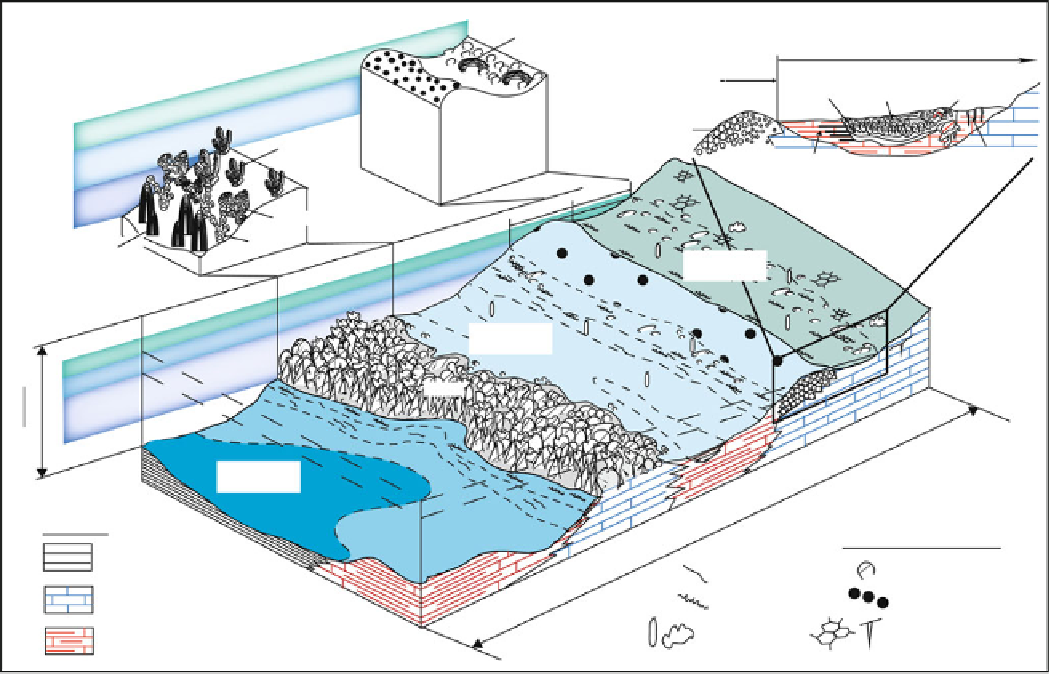Geology Reference
In-Depth Information
Omachtenia (?)
Stratifera
Pond
Shoal
Laminar
crusts
Collapse
breccia
Stromatolites
MF9
MF10c
MF10a
MF10b
High Tide
Baicalia
Desiccation
Mud
Tungussia
Kasaia
Conophyton
MF11
Lacustrine
Environment
MF10
MF9
MF8
Evaporative
Environment
MF7
MF6
MF5
MF4
MF3
MF2
Marine
Environment
MF1
Lithology
Sedimentary structure
OM-rich dolomudstone
Planar laminae
Wavy laminae
Stromatolite
Dolomite
Oolite/Oncolite
Desiccation crack
Evaporate
Dolomudstone
Fig. 4.7
Schematic reconstitution of depositional environments of the
carbonate Mbuji-Mayi ramp. Idealized 3D-model illustrating the dis-
tribution of microfacies (MF1-MF11) from the outer-, middle- and
inner-ramp system, with evaporative lacustrine ponds and sabkha. No
vertical and horizontal scales. Ecological distribution of stromatolites is
also shown in the middle ramp zone
Fischer plots: thin cycles characterize a stabilized curve with
slight falling limbs, while thick cycles dominate the rising
limbs of the plot. This suggests that fluctuations in eustacy
had a strong control on the cyclicity
masses in ramps affecting carbonates during early diagene-
sis. In contrast, Allan and Matthews (
1982
) argued that the
low isotopic values of carbonates in the ramp are mainly
related to (i) influence of
18
O-depleted early meteoric fluids
and a
13
C-depleted soil-zone CO
2
(overprinting heavier
marine values during a sea level fall and (ii) effects of
'
4.6.4 Sequence Stratigraphy Versus Carbon
Isotope Curve
with oxidation of organic matter in
CO
2
, which increase of bicarbonate concentrations in shal-
low poorly circulated sea water masses (e.g. Holmden et al.
1998
). In our study, the relationship between cycle-thickness
variations reflecting third-order changes, and
sea-water ageing
'
13
C isotopic data
(Delpomdor et al.
2013a
) displays alternations of
Combining the Fischer plots with our
δ
13
C
positive-negative shifts in tune with cycle-thickness
variations that reflect third-order and possible fourth-order
changes in accommodation space available. The BII
carbonates exhibit
13
C variations
in the Mbuji-Mayi carbonate Supergroup, are linked
(Fig.
4.6
). We have shown that transgressive sequences
highlighted transgressive systems tracts (TST) while
δ
δ
rela-
'
18
O isotopic trends towards
higher values, reflecting open-marine signatures episodi-
cally subjected to evaporitic conditions, and towards lower
values reflecting early meteoric and burial signatures
(Delpomdor and Pr´at
2013
). Immenhauser et al. (
2003
)
attempted to explain local variations of C and O isotope
shifts in the Late Carboniferous Atokan series in northern
Spain as a result of chemical changes of marine water
13
C and
δ
δ
tive
stages of
highstand systems tracts (HST). Two trends are identified (i)
'
'
regressive sequences developed during
'
late
'
long term
'
negative slopes in the Fischer curve, with nega-
13
C excursions; and (ii)
tive
δ
long term
positive slopes
'
'
13
C excursions. These trends sug-
gest that (i) during transgressive systems tracts (TST) circu-
lation of ramp-top marine water-masses was enhanced, and
effects of meteoric diagenesis on ramp-top carbonates were
associated with positive
δ


Search WWH ::

Custom Search